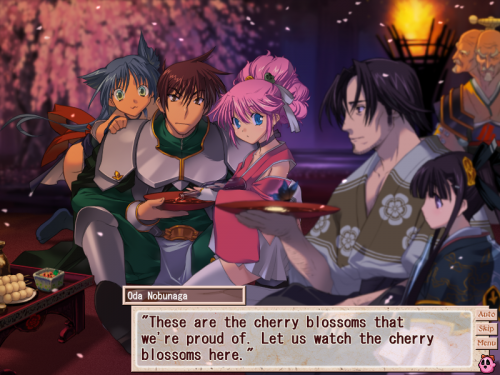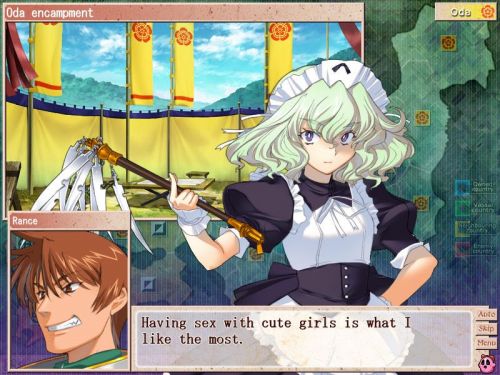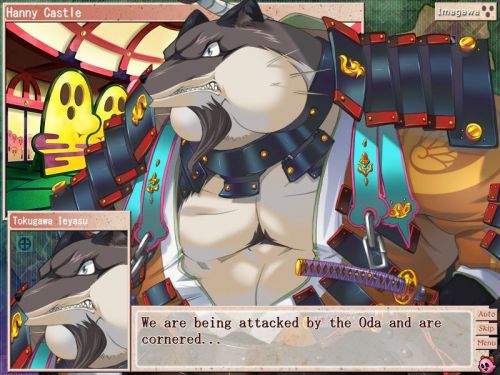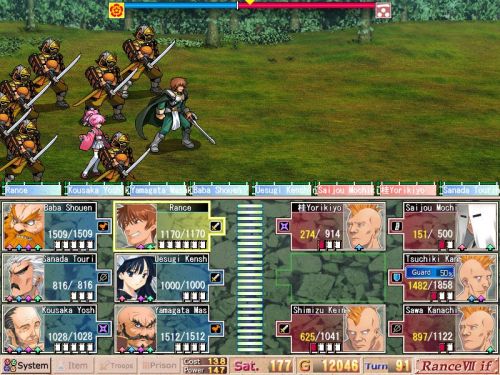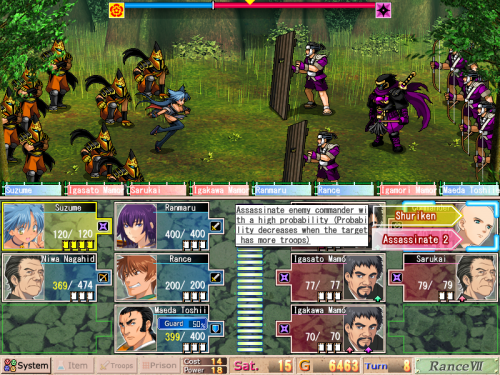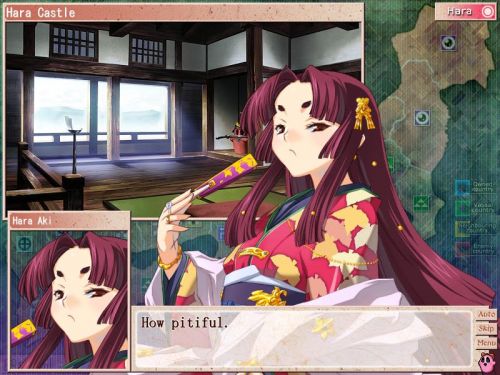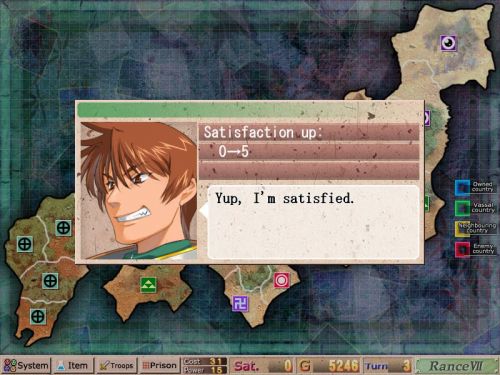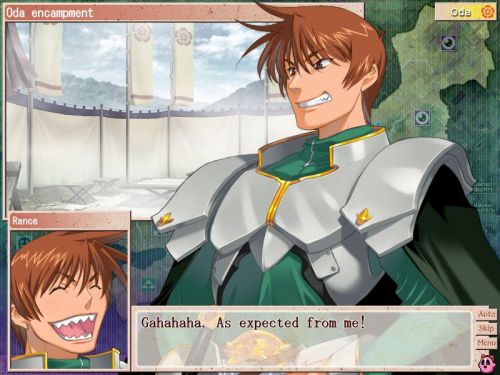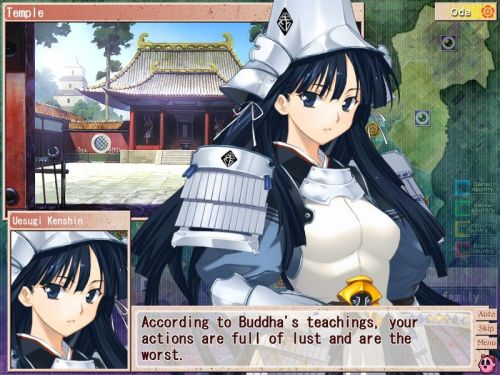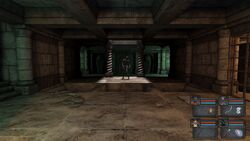RPG Codex Review: Sengoku Rance
RPG Codex Review: Sengoku Rance
Codex Review - posted by Infinitron on Sat 19 October 2019, 01:40:51
Tags: AliceSoft; Sengoku RanceCodexers don't usually like JRPGs, but when they do they're often games from the Rance series, the long-running line of satirical eroge RPGs by Japanese developer AliceSoft. Everybody knows the best game in the series is Sengoku Rance, the 2006 strategy RPG in which the titular character sets out to conquer a fictionalized version of Warring States-period Japan. After years of being played in the West exclusively using fan translations, Sengoku Rance was finally officially released in English last month. Which means it's time to finally publish this review of the game by Deuce Traveler that we've been saving up for over a year(!). Here's an excerpt:
Read the full article: RPG Codex Review: Sengoku Rance
I'm going to take a moment to compare the strategic layer of Sengoku Rance to grand strategy mainstays such as Europa Universalis or the Romance of the Three Kingdoms series. During a given turn in a grand strategy game, you gauge the strength of your enemy and then build up the appropriate forces to take a territory you want. You are likely to be victorious on the field, but there are other factors which determine if the attack will have been worthwhile. For example, what resources were lost to ensure the victory? Were your best officers and units used up in the attack, leaving only scrubs and depleted troops available to defend what you won during that turn? What enemy resources were captured that would make the losses acceptable? How will the rulers of opposing factions react? Will your enemies seek an alliance, declare war, offer tribute in the hopes of staying neutral, or act in the shadows in an attempt to weaken your forces? There’s a lot of complexity in a typical grand strategy title, but Sengoku Rance is probably one of the most accessible and easy to learn of this genre.
There are continuous choices and consequences to your actions as the game unfolds. For example, one industrious clan sells powerful weapons to its sole ally but also offers to sell rifle units to you. However, if you attack the ally of this arms dealing territory they will begin to sell their weapons to everyone in the hopes of slowing your conquests down without having to actively engage you. To avoid this you could make the allied clan your vassal instead of invading them, but then you miss out on having greater control of their territory.
During the latter part of the game you find yourself having to fight on multiple fronts, but you have the option to shut a large gateway and trap one of your opponents behind it. Doing so protects your flank, but the gate cannot be opened again and you lose the opportunity to claim more territory and capture its powerful commanders. Most of the more well-known grand strategy games are sandboxes where events are essentially random. Sengoku Rance has a much more static world, but it compensates by having tons of scripted events, most of which are impossible to witness in a single playthrough. You will likely have to beat the game more than a half-dozen times to see the majority of its hidden lore.
Sengoku Rance's characters are some of the most distinct and memorable in the history of video games. The leaders and subordinate officers of the game’s various factions each stand out in their own small way thanks to its well-drawn art and visual novel storytelling. One of the first factions you go to war with is led by the leader of a strong unit of archers who has one of the best special skills for ranged units, but he’s beaten down by life and constantly pushed into making poor military decisions by his beautiful and spoiled wife. Another faction is led by a giant creature called a raccoon dog and his army of smaller furry ninjas. They inherited their territory after capturing it from their human oppressors and hope to take advantage of Rance’s rise to weaken their neighbors. A third faction is led by a corrupt court, but their greatest officer is the game’s equivalent of a virtuous paladin who will lead her unit in support of factions Rance declares war against. Ironically, she and her best friend end up having more to fear from the machinations of those she serves. Later in the game, Rance will come into contact with a nation of undead soldiers led by a samurai eyeball and his harem of supportive, monstrous wives. Most of the officers and units of this particular faction are subpar, but they lead huge forces and battles with them become particularly difficult if one of the wives is part of the attacking army. I can think of no other game where there are so many factions with such distinctly drawn characters, each of which gets their own small moment to shine. Sengoku Rance is one of the few games out there where the visual novel style of storytelling feels well-integrated with the flow of gameplay.
[...] Your ultimate goal is to take over this world's version of Japan during an alternate Warring States period, in which the historical figures have been replaced by political parodies. Combat is a simple affair. Place your melee fighters on the front row to protect support units that operate in the back. During battles, you can place up to six commanders and their units onto the battlefield to slog it out. You start off the game running the Oda Clan with a few basic types of units, such as warriors like Rance who have high offensive attributes and skills that allow them to perform special offensive maneuvers. Complementing them are commanders of foot soldiers, whose attacks aren’t as powerful, but have high defensive attributes and specialized skills for protecting allied units. You are also given a commander of archers, whose attacks are not as powerful as warriors either, but can attack from the back row and strike any enemy unit regardless of location. Archers are quite useful for disrupting spell casters who are preparing their more powerful spells from the enemy’s back row. Finally, you are given a tactician commander, whose skills can be used to enhance the fighting abilities of allied units or diminish those of the enemy.
Sengoku Rance starts you out with these basic units and gradually adds more diverse character classes as you proceed through the game. The ninja behaves in a similar way to the archer, but can quickly learn the assassinate skill which allows it to instantly wipe out enemy units. Monks are decent front row melee fighters who also have an assortment of skills, such as the ability to heal themselves or make foot soldiers drop their guard. Diviner commanders can throw up barriers to guard their allies, or spend some time chanting in order to cast a spell that strikes at each of the opposing enemy units. Musketeers are the most deadly units on the battlefield, but they can't take much damage and can only attack once or twice before exhausting all of their actions for the entire battle. Cavalry units are the ones I fear the most, since they can attack multiple times, have great offensive attributes, and can strike any unit regardless of whether they’re in the front or back rows. I still haven't touched upon some of the more unique commanders and their abilities, nor have I talked about the non-human units. In short, there's a lot of variation in the opponents you will face.
The handful of officers you start out with are a dubious group of misfits that you are forced to rely upon to survive (although Rance himself is the backbone of your offense at this stage). One of the game’s more charming aspects is how even the minor officers on both sides of the battlefield have their own personalities and quirks. By improving your relationship with your officers, upgrading their ability scores with books, and equipping them with items, you will have a chance to turn some of the more mediocre recruits into a respectable fighting force. Every officer has several attributes which determine how fast they can act, how hard they attack, how well they defend, how well they search, and how effective they are at diplomacy. Some officers also have unlockable special abilities, such as the ability to fire a volley of arrows that peppers an entire enemy force instead of just one opposing unit. You can only have thirty officers in your roster and by mid-game you'll find yourself having to make hard choices about who will make the cut.
There are continuous choices and consequences to your actions as the game unfolds. For example, one industrious clan sells powerful weapons to its sole ally but also offers to sell rifle units to you. However, if you attack the ally of this arms dealing territory they will begin to sell their weapons to everyone in the hopes of slowing your conquests down without having to actively engage you. To avoid this you could make the allied clan your vassal instead of invading them, but then you miss out on having greater control of their territory.
During the latter part of the game you find yourself having to fight on multiple fronts, but you have the option to shut a large gateway and trap one of your opponents behind it. Doing so protects your flank, but the gate cannot be opened again and you lose the opportunity to claim more territory and capture its powerful commanders. Most of the more well-known grand strategy games are sandboxes where events are essentially random. Sengoku Rance has a much more static world, but it compensates by having tons of scripted events, most of which are impossible to witness in a single playthrough. You will likely have to beat the game more than a half-dozen times to see the majority of its hidden lore.
Sengoku Rance's characters are some of the most distinct and memorable in the history of video games. The leaders and subordinate officers of the game’s various factions each stand out in their own small way thanks to its well-drawn art and visual novel storytelling. One of the first factions you go to war with is led by the leader of a strong unit of archers who has one of the best special skills for ranged units, but he’s beaten down by life and constantly pushed into making poor military decisions by his beautiful and spoiled wife. Another faction is led by a giant creature called a raccoon dog and his army of smaller furry ninjas. They inherited their territory after capturing it from their human oppressors and hope to take advantage of Rance’s rise to weaken their neighbors. A third faction is led by a corrupt court, but their greatest officer is the game’s equivalent of a virtuous paladin who will lead her unit in support of factions Rance declares war against. Ironically, she and her best friend end up having more to fear from the machinations of those she serves. Later in the game, Rance will come into contact with a nation of undead soldiers led by a samurai eyeball and his harem of supportive, monstrous wives. Most of the officers and units of this particular faction are subpar, but they lead huge forces and battles with them become particularly difficult if one of the wives is part of the attacking army. I can think of no other game where there are so many factions with such distinctly drawn characters, each of which gets their own small moment to shine. Sengoku Rance is one of the few games out there where the visual novel style of storytelling feels well-integrated with the flow of gameplay.
[...] Your ultimate goal is to take over this world's version of Japan during an alternate Warring States period, in which the historical figures have been replaced by political parodies. Combat is a simple affair. Place your melee fighters on the front row to protect support units that operate in the back. During battles, you can place up to six commanders and their units onto the battlefield to slog it out. You start off the game running the Oda Clan with a few basic types of units, such as warriors like Rance who have high offensive attributes and skills that allow them to perform special offensive maneuvers. Complementing them are commanders of foot soldiers, whose attacks aren’t as powerful, but have high defensive attributes and specialized skills for protecting allied units. You are also given a commander of archers, whose attacks are not as powerful as warriors either, but can attack from the back row and strike any enemy unit regardless of location. Archers are quite useful for disrupting spell casters who are preparing their more powerful spells from the enemy’s back row. Finally, you are given a tactician commander, whose skills can be used to enhance the fighting abilities of allied units or diminish those of the enemy.
Sengoku Rance starts you out with these basic units and gradually adds more diverse character classes as you proceed through the game. The ninja behaves in a similar way to the archer, but can quickly learn the assassinate skill which allows it to instantly wipe out enemy units. Monks are decent front row melee fighters who also have an assortment of skills, such as the ability to heal themselves or make foot soldiers drop their guard. Diviner commanders can throw up barriers to guard their allies, or spend some time chanting in order to cast a spell that strikes at each of the opposing enemy units. Musketeers are the most deadly units on the battlefield, but they can't take much damage and can only attack once or twice before exhausting all of their actions for the entire battle. Cavalry units are the ones I fear the most, since they can attack multiple times, have great offensive attributes, and can strike any unit regardless of whether they’re in the front or back rows. I still haven't touched upon some of the more unique commanders and their abilities, nor have I talked about the non-human units. In short, there's a lot of variation in the opponents you will face.
The handful of officers you start out with are a dubious group of misfits that you are forced to rely upon to survive (although Rance himself is the backbone of your offense at this stage). One of the game’s more charming aspects is how even the minor officers on both sides of the battlefield have their own personalities and quirks. By improving your relationship with your officers, upgrading their ability scores with books, and equipping them with items, you will have a chance to turn some of the more mediocre recruits into a respectable fighting force. Every officer has several attributes which determine how fast they can act, how hard they attack, how well they defend, how well they search, and how effective they are at diplomacy. Some officers also have unlockable special abilities, such as the ability to fire a volley of arrows that peppers an entire enemy force instead of just one opposing unit. You can only have thirty officers in your roster and by mid-game you'll find yourself having to make hard choices about who will make the cut.
Read the full article: RPG Codex Review: Sengoku Rance
[Review by Deuce Traveler]
Background
The Rance series is the flagship RPG line from Japanese developer AliceSoft. In these satirical adventures, the eponymous character Rance cuts a path through the world seeking sex, profit and fame. The chief god of the setting’s religious pantheon is an absent-minded whale who runs a crapsack world of violence and suffering for his own entertainment. This deity is opposed by the openly malevolent Devil King who wishes to remake the world such that mankind would be even worse off. The ruling class of the human kingdoms with few exceptions is petty and abusive. An arbitrary system of divine level caps creates a class structure in which most people can never rise above their station, a divine level cap that Rance somehow avoided having assigned to him upon birth. And so the irony in each of these games is that as horrible as Rance is, there are usually powerful human leaders and scheming demons who are a whole lot worse, requiring the oppressed to ignore Rance's crimes and call upon him for aid. The Rance series has featured various forms of gameplay throughout its history, from top-down dungeon crawling to first-person blobbering to isometric tactical combat. Sengoku Rance, also known as Rance 7, is a strategic conquest RPG.
Welcome to Grand Strategy, Rance Style
I'm going to take a moment to compare the strategic layer of Sengoku Rance to grand strategy mainstays such as Europa Universalis or the Romance of the Three Kingdoms series. During a given turn in a grand strategy game, you gauge the strength of your enemy and then build up the appropriate forces to take a territory you want. You are likely to be victorious on the field, but there are other factors which determine if the attack will have been worthwhile. For example, what resources were lost to ensure the victory? Were your best officers and units used up in the attack, leaving only scrubs and depleted troops available to defend what you won during that turn? What enemy resources were captured that would make the losses acceptable? How will the rulers of opposing factions react? Will your enemies seek an alliance, declare war, offer tribute in the hopes of staying neutral, or act in the shadows in an attempt to weaken your forces? There’s a lot of complexity in a typical grand strategy title, but Sengoku Rance is probably one of the most accessible and easy to learn of this genre.
There are continuous choices and consequences to your actions as the game unfolds. For example, one industrious clan sells powerful weapons to its sole ally but also offers to sell rifle units to you. However, if you attack the ally of this arms dealing territory they will begin to sell their weapons to everyone in the hopes of slowing your conquests down without having to actively engage you. To avoid this you could make the allied clan your vassal instead of invading them, but then you miss out on having greater control of their territory.
During the latter part of the game you find yourself having to fight on multiple fronts, but you have the option to shut a large gateway and trap one of your opponents behind it. Doing so protects your flank, but the gate cannot be opened again and you lose the opportunity to claim more territory and capture its powerful commanders. Most of the more well-known grand strategy games are sandboxes where events are essentially random. Sengoku Rance has a much more static world, but it compensates by having tons of scripted events, most of which are impossible to witness in a single playthrough. You will likely have to beat the game more than a half-dozen times to see the majority of its hidden lore.
Sengoku Rance's characters are some of the most distinct and memorable in the history of video games. The leaders and subordinate officers of the game’s various factions each stand out in their own small way thanks to its well-drawn art and visual novel storytelling. One of the first factions you go to war with is led by the leader of a strong unit of archers who has one of the best special skills for ranged units, but he’s beaten down by life and constantly pushed into making poor military decisions by his beautiful and spoiled wife. Another faction is led by a giant creature called a raccoon dog and his army of smaller furry ninjas. They inherited their territory after capturing it from their human oppressors and hope to take advantage of Rance’s rise to weaken their neighbors. A third faction is led by a corrupt court, but their greatest officer is the game’s equivalent of a virtuous paladin who will lead her unit in support of factions Rance declares war against. Ironically, she and her best friend end up having more to fear from the machinations of those she serves. Later in the game, Rance will come into contact with a nation of undead soldiers led by a samurai eyeball and his harem of supportive, monstrous wives. Most of the officers and units of this particular faction are subpar, but they lead huge forces and battles with them become particularly difficult if one of the wives is part of the attacking army. I can think of no other game where there are so many factions with such distinctly drawn characters, each of which gets their own small moment to shine. Sengoku Rance is one of the few games out there where the visual novel style of storytelling feels well-integrated with the flow of gameplay.
Combat
Your ultimate goal is to take over this world's version of Japan during an alternate Warring States period, in which the historical figures have been replaced by political parodies. Combat is a simple affair. Place your melee fighters on the front row to protect support units that operate in the back. During battles, you can place up to six commanders and their units onto the battlefield to slog it out. You start off the game running the Oda Clan with a few basic types of units, such as warriors like Rance who have high offensive attributes and skills that allow them to perform special offensive maneuvers. Complementing them are commanders of foot soldiers, whose attacks aren’t as powerful, but have high defensive attributes and specialized skills for protecting allied units. You are also given a commander of archers, whose attacks are not as powerful as warriors either, but can attack from the back row and strike any enemy unit regardless of location. Archers are quite useful for disrupting spell casters who are preparing their more powerful spells from the enemy’s back row. Finally, you are given a tactician commander, whose skills can be used to enhance the fighting abilities of allied units or diminish those of the enemy.
Sengoku Rance starts you out with these basic units and gradually adds more diverse character classes as you proceed through the game. The ninja behaves in a similar way to the archer, but can quickly learn the assassinate skill which allows it to instantly wipe out enemy units. Monks are decent front row melee fighters who also have an assortment of skills, such as the ability to heal themselves or make foot soldiers drop their guard. Diviner commanders can throw up barriers to guard their allies, or spend some time chanting in order to cast a spell that strikes at each of the opposing enemy units. Musketeers are the most deadly units on the battlefield, but they can't take much damage and can only attack once or twice before exhausting all of their actions for the entire battle. Cavalry units are the ones I fear the most, since they can attack multiple times, have great offensive attributes, and can strike any unit regardless of whether they’re in the front or back rows. I still haven't touched upon some of the more unique commanders and their abilities, nor have I talked about the non-human units. In short, there's a lot of variation in the opponents you will face.
The handful of officers you start out with are a dubious group of misfits that you are forced to rely upon to survive (although Rance himself is the backbone of your offense at this stage). One of the game’s more charming aspects is how even the minor officers on both sides of the battlefield have their own personalities and quirks. By improving your relationship with your officers, upgrading their ability scores with books, and equipping them with items, you will have a chance to turn some of the more mediocre recruits into a respectable fighting force. Every officer has several attributes which determine how fast they can act, how hard they attack, how well they defend, how well they search, and how effective they are at diplomacy. Some officers also have unlockable special abilities, such as the ability to fire a volley of arrows that peppers an entire enemy force instead of just one opposing unit. You can only have thirty officers in your roster and by mid-game you'll find yourself having to make hard choices about who will make the cut.
Certain characters have their own side quests that can be explored if you choose the correct actions. One of my favorite characters is an awesome tank and killing machine, but you can only recruit her once she is liberated from a cell in a particular territory. Afterwards, she will only stay in your roster for a short period of time unless you promise to find a challenge matching her capabilities. If you do, and she survives, she becomes one of your most loyal allies and begins to improve her attributes at an amazing rate every time she fights alongside Rance, maxing out towards the final third of the game if you pick her up early and use her often enough.
The more troops an officer has under his or her command, the more damage they inflict upon the enemy. Troops also represent the unit’s hit points, so when an officer runs out of troops then both the officer and his or her unit is out of the fight. During battles, there’s a status bar at the top of the screen split between red and blue colors which represents whether you or your opponent have control of the field. The status bar moves horizontally depending on how much damage your side is giving or taking. You can win a battle by either eliminating all enemy forces or doing well enough to 'push' the enemy off the field, which will be represented on screen by the status bar showing more blue than red. Once you get some experience under your belt and have a solid cadre of recruitable officers, you’ll be able to put together a strong mix of offensive and defensive units. However, the challenge in Sengoku Rance does not come from fighting individual battles.
Strategy
At first you can only make a couple of moves per turn, represented by action fans. Within your own empire, you can recruit masterless officers, search for legendary items, explore dungeons, improve defenses, upgrade a territory's economy, conduct a levy for funds and items, or perform other miscellaneous activities such as going on hunts or visiting a carnival. When clicking on another clan's territory you have the option to listen for rumors, declare war, invade, or attempt to damage the territory's capabilities. There are also actions that don’t require fans, such as reconstituting a depleted unit, increasing the maximum number of troops in a unit, equipping an officer, dismissing officers from your ranks, or attempting to recruit captured enemy officers. Your enemies will not be idle either. In between turns they may declare war on you, recruit officers, increase the size of their militaries, attack other clans, or beseech one another for aid.
Combat occurs when you invade a territory, or when an enemy lord attacks one of your own territories. When an invader wins a battle, he takes a fortification from the invaded territory and comes one step closer towards conquering it. Most territories have two to four fortifications that have to be taken before they can be conquered by an invader. When you defeat a unit by eliminating all of its troops, the fate of its officer is determined randomly. The defeated officer may escape, be killed or be captured. Those who escape might face you again later on, while those who are captured you can visit in prison and attempt to recruit.
The number of officers you can hold in your prison is limited, so you have the option of releasing them (which means they might be recruited by one of the other lords) or simply executing them. If an enemy lord loses all of his territory to you, he will either surrender to your rule or be executed, and his surviving commanders will either be captured or escape. More territories under your control leads to greater revenue, allowing you to field a larger fighting force. Because of the randomness of its dynamic rosters, no two sessions of Sengoku Rance will ever unfold in the same way.
The replayability of Sengoku Rance can’t be overstated. One player might take their time developing their troops and territory, waiting for the other clans to declare war on them before counter-attacking. Another player might forego development and go right for the attack. Events will play out quite differently due to these choices. Aggressive players will experience different events depending on the direction they choose to expand. Other players might decide to advance through diplomacy instead of outright invasion, which will cause some clan leaders to see Rance in a different light. Every clan has its own subplot, and often the way the player chooses to deal with them will have unforeseen consequences. That’s why I keep returning to this game. You never know what new event you might discover from replay to replay. It feels like one of the classic Koei strategy games, but with more RPG elements and a twisted sense of humor.
However, the game isn't without its problems. For instance, you can’t beat the game until certain parts of the story have played out. It’s frustrating to push the last surviving faction to its last handful of territories, only for them to block every attack you throw at them simply because the game still has a visual novel sequence left to tell. And of course, there’s the fact that Rance and the villains frequently assault female characters, resulting in graphic scenes that may be disturbing and cause some players to quit before they get very far.
Dungeons
Another important activity in Sengoku Rance is dungeon crawling. Instead of fighting against enemy officers, your characters battle it out against monsters that will be familiar to those who have played previous Rance titles. Each level of a dungeon is represented by a single bout of combat, with loot gained upon completion. This usually becomes an endurance test, since your adventurers have only a limited amount of actions before they become exhausted and have to be pulled out and replaced with fresh characters from your roster.
Since your officers are fighting as individuals, their attack power is determined by their personal fighting ability instead of the amount of troops they’re leading. If Rance and his companions are able to beat all of a dungeon’s levels, the dungeon is conquered and you gain a unique reward. Your companions will each gain a level, making them that much tougher in future dungeon excursions (at least until they run into their level caps). Completed dungeons can be revisited, but there is rarely any reason to do so. The dungeons are a weak point of Sengoku Rance compared to previous games in the series. I can't claim that any of them stood out as great examples of dungeon design, but most of them beat out Sengoku Rance.
Story
Sengoku Rance’s storyline is tricky. It starts off simply enough, when the titular Rance is given control of the Oda clan, its sole territory and its army. Since Rance is completely unfit for any role requiring decorum and diplomacy, this quickly leads to animosity between Oda and its already aggressive neighbors, and eventually open warfare. From that point on, the player's goal is to unite Japan under his rule. This goal is complicated by the fact that Rance is a self-destructive character out to get drunk, get rich, and molest women (not necessarily in that order). He’s meant to be a parody of the RPG hero, who is constantly surrounded by scantily clad females, always ready to rescue any captured maidens, and uses violence as a solution for 99% of the problems he encounters. When you play a Rance game, you know what you’re getting yourself into.
Rance gains satisfaction when he does things that he enjoys, such as sleeping with women, enjoying hobbies, and visiting sites such as carnivals. For every 10 points of satisfaction you earn, you’ll be able to spend an action fan to activate a special satisfaction event, such as discovering a special ability, gaining a level, or summoning an ally from a previous game to become an officer in Rance’s army. If you have a high enough satisfaction score, you can even gain additional action fans.
Your officers each have an attitude meter indicating the state of their relationship with Rance. If you use a character often enough or use them alongside Rance, they have a chance of gaining a point. You can also have Rance spend some time with a character to improve their relations. For every seven points gained, the relationship will be upgraded to a more positive state, so that over time even a freed prisoner might go from being hostile towards Rance to falling in love with him. The officer will also get to improve an attribute, gain a level, or learn a new skill. Some officers get unique bonuses that you’ll want to discover. In fact, it’s often worthwhile to spend actions on improving relations with your officers instead of waging war. However, you won’t be able to trigger every satisfaction event or max out the attitude meters of every one of your officers in a single playthrough.
Some characters from previous Rance games show up in Sengoku Rance. Although you might attribute their relationships with Rance to short-sightedness or even some sort of Stockholm Syndrome, this continues the ‘larger world’ theme established at the end of Rance 6, where Rance is surrounded by a large group of companions with a shared history. Over the course of the game he meets new friends who he begins to appreciate and feel a responsibility towards, showing a more protective side of Rance as he evolves as a character throughout the series. When a certain tragedy occurs at a particular point in the story, Rance becomes despondent, entering a cycle of depression (with an actual gameplay impact) until the game's conclusion. Sengoku Rance starts out as comedic parody, turns into a game about choice and consequence, and finishes as grim horror. It's a gradual change executed well.
The Routes
I’ve already mentioned how replayable Sengoku Rance is. It’s much more involved than just choosing a few different dialogue options to get a different ending. Once you’ve successfully beaten the game once, four alternate routes towards finishing it open up. You only get to see them if you make the right choices in the first act. The alternate routes drastically change the game’s story. The primary antagonists and your inner circle of officers end up being entirely different. Each one of these routes contains enough new content to have been sold as an expansion.
Each route has an internal timeline of events that results in you being unable to do everything before the game ends. You can’t recruit all of the officers you would need to see everything in the game in a single playthrough, and your opponents won't wait patiently for you to explore all of your available choices before declaring war on you and forcing you to act. I'm still finding new dialogue in the game after playing through five different routes and recruiting all of the available clans.
If that's not enough replayability for you, you can also increase the game’s difficulty, which starts the opposing clans with greater military resources and makes them more aggressive. To make things easier, you can spend points earned in your previous playthrough to acquire bonuses such as additional action fans, more officers, better resources, helpful equipment, or officers from a previously conquered clan. Another gameplay mode allows you to play the game as a rival clan with entirely different starting territories. There’s even a Kichikuou Rance mod out there in case you want to play the previous Rance strategy RPG with the new engine. Combined with the random behavior of the various computer-controlled opponents, these options guarantee hundreds of hours of additional replay value.
Conclusion
I've sunk hundreds of hours into Sengoku Rance, much more than any other strategy RPG outside of Romance of the Three Kingdoms X. It's definitely the best game in the Rance series, with unforgettable characters, a plot full of twists and turns, a wide variety of units and combat mechanics, multiple endings available after the canonical one, and lots of secrets to discover. I highly recommend you all give it a try even if eroge is not your thing. Although the absence of quality dungeon crawling is a huge detriment to the game, its strategy layer offers a great balance of accessibility and complexity, making Sengoku Rance an ideal entryway to the genre. Buy the official MangaGamer English release and prepare to lose countless hours of your life.
Background
The Rance series is the flagship RPG line from Japanese developer AliceSoft. In these satirical adventures, the eponymous character Rance cuts a path through the world seeking sex, profit and fame. The chief god of the setting’s religious pantheon is an absent-minded whale who runs a crapsack world of violence and suffering for his own entertainment. This deity is opposed by the openly malevolent Devil King who wishes to remake the world such that mankind would be even worse off. The ruling class of the human kingdoms with few exceptions is petty and abusive. An arbitrary system of divine level caps creates a class structure in which most people can never rise above their station, a divine level cap that Rance somehow avoided having assigned to him upon birth. And so the irony in each of these games is that as horrible as Rance is, there are usually powerful human leaders and scheming demons who are a whole lot worse, requiring the oppressed to ignore Rance's crimes and call upon him for aid. The Rance series has featured various forms of gameplay throughout its history, from top-down dungeon crawling to first-person blobbering to isometric tactical combat. Sengoku Rance, also known as Rance 7, is a strategic conquest RPG.
Welcome to Grand Strategy, Rance Style
I'm going to take a moment to compare the strategic layer of Sengoku Rance to grand strategy mainstays such as Europa Universalis or the Romance of the Three Kingdoms series. During a given turn in a grand strategy game, you gauge the strength of your enemy and then build up the appropriate forces to take a territory you want. You are likely to be victorious on the field, but there are other factors which determine if the attack will have been worthwhile. For example, what resources were lost to ensure the victory? Were your best officers and units used up in the attack, leaving only scrubs and depleted troops available to defend what you won during that turn? What enemy resources were captured that would make the losses acceptable? How will the rulers of opposing factions react? Will your enemies seek an alliance, declare war, offer tribute in the hopes of staying neutral, or act in the shadows in an attempt to weaken your forces? There’s a lot of complexity in a typical grand strategy title, but Sengoku Rance is probably one of the most accessible and easy to learn of this genre.
There are continuous choices and consequences to your actions as the game unfolds. For example, one industrious clan sells powerful weapons to its sole ally but also offers to sell rifle units to you. However, if you attack the ally of this arms dealing territory they will begin to sell their weapons to everyone in the hopes of slowing your conquests down without having to actively engage you. To avoid this you could make the allied clan your vassal instead of invading them, but then you miss out on having greater control of their territory.
During the latter part of the game you find yourself having to fight on multiple fronts, but you have the option to shut a large gateway and trap one of your opponents behind it. Doing so protects your flank, but the gate cannot be opened again and you lose the opportunity to claim more territory and capture its powerful commanders. Most of the more well-known grand strategy games are sandboxes where events are essentially random. Sengoku Rance has a much more static world, but it compensates by having tons of scripted events, most of which are impossible to witness in a single playthrough. You will likely have to beat the game more than a half-dozen times to see the majority of its hidden lore.
Sengoku Rance's characters are some of the most distinct and memorable in the history of video games. The leaders and subordinate officers of the game’s various factions each stand out in their own small way thanks to its well-drawn art and visual novel storytelling. One of the first factions you go to war with is led by the leader of a strong unit of archers who has one of the best special skills for ranged units, but he’s beaten down by life and constantly pushed into making poor military decisions by his beautiful and spoiled wife. Another faction is led by a giant creature called a raccoon dog and his army of smaller furry ninjas. They inherited their territory after capturing it from their human oppressors and hope to take advantage of Rance’s rise to weaken their neighbors. A third faction is led by a corrupt court, but their greatest officer is the game’s equivalent of a virtuous paladin who will lead her unit in support of factions Rance declares war against. Ironically, she and her best friend end up having more to fear from the machinations of those she serves. Later in the game, Rance will come into contact with a nation of undead soldiers led by a samurai eyeball and his harem of supportive, monstrous wives. Most of the officers and units of this particular faction are subpar, but they lead huge forces and battles with them become particularly difficult if one of the wives is part of the attacking army. I can think of no other game where there are so many factions with such distinctly drawn characters, each of which gets their own small moment to shine. Sengoku Rance is one of the few games out there where the visual novel style of storytelling feels well-integrated with the flow of gameplay.
Combat
Your ultimate goal is to take over this world's version of Japan during an alternate Warring States period, in which the historical figures have been replaced by political parodies. Combat is a simple affair. Place your melee fighters on the front row to protect support units that operate in the back. During battles, you can place up to six commanders and their units onto the battlefield to slog it out. You start off the game running the Oda Clan with a few basic types of units, such as warriors like Rance who have high offensive attributes and skills that allow them to perform special offensive maneuvers. Complementing them are commanders of foot soldiers, whose attacks aren’t as powerful, but have high defensive attributes and specialized skills for protecting allied units. You are also given a commander of archers, whose attacks are not as powerful as warriors either, but can attack from the back row and strike any enemy unit regardless of location. Archers are quite useful for disrupting spell casters who are preparing their more powerful spells from the enemy’s back row. Finally, you are given a tactician commander, whose skills can be used to enhance the fighting abilities of allied units or diminish those of the enemy.
Sengoku Rance starts you out with these basic units and gradually adds more diverse character classes as you proceed through the game. The ninja behaves in a similar way to the archer, but can quickly learn the assassinate skill which allows it to instantly wipe out enemy units. Monks are decent front row melee fighters who also have an assortment of skills, such as the ability to heal themselves or make foot soldiers drop their guard. Diviner commanders can throw up barriers to guard their allies, or spend some time chanting in order to cast a spell that strikes at each of the opposing enemy units. Musketeers are the most deadly units on the battlefield, but they can't take much damage and can only attack once or twice before exhausting all of their actions for the entire battle. Cavalry units are the ones I fear the most, since they can attack multiple times, have great offensive attributes, and can strike any unit regardless of whether they’re in the front or back rows. I still haven't touched upon some of the more unique commanders and their abilities, nor have I talked about the non-human units. In short, there's a lot of variation in the opponents you will face.
The handful of officers you start out with are a dubious group of misfits that you are forced to rely upon to survive (although Rance himself is the backbone of your offense at this stage). One of the game’s more charming aspects is how even the minor officers on both sides of the battlefield have their own personalities and quirks. By improving your relationship with your officers, upgrading their ability scores with books, and equipping them with items, you will have a chance to turn some of the more mediocre recruits into a respectable fighting force. Every officer has several attributes which determine how fast they can act, how hard they attack, how well they defend, how well they search, and how effective they are at diplomacy. Some officers also have unlockable special abilities, such as the ability to fire a volley of arrows that peppers an entire enemy force instead of just one opposing unit. You can only have thirty officers in your roster and by mid-game you'll find yourself having to make hard choices about who will make the cut.
Certain characters have their own side quests that can be explored if you choose the correct actions. One of my favorite characters is an awesome tank and killing machine, but you can only recruit her once she is liberated from a cell in a particular territory. Afterwards, she will only stay in your roster for a short period of time unless you promise to find a challenge matching her capabilities. If you do, and she survives, she becomes one of your most loyal allies and begins to improve her attributes at an amazing rate every time she fights alongside Rance, maxing out towards the final third of the game if you pick her up early and use her often enough.
The more troops an officer has under his or her command, the more damage they inflict upon the enemy. Troops also represent the unit’s hit points, so when an officer runs out of troops then both the officer and his or her unit is out of the fight. During battles, there’s a status bar at the top of the screen split between red and blue colors which represents whether you or your opponent have control of the field. The status bar moves horizontally depending on how much damage your side is giving or taking. You can win a battle by either eliminating all enemy forces or doing well enough to 'push' the enemy off the field, which will be represented on screen by the status bar showing more blue than red. Once you get some experience under your belt and have a solid cadre of recruitable officers, you’ll be able to put together a strong mix of offensive and defensive units. However, the challenge in Sengoku Rance does not come from fighting individual battles.
Strategy
At first you can only make a couple of moves per turn, represented by action fans. Within your own empire, you can recruit masterless officers, search for legendary items, explore dungeons, improve defenses, upgrade a territory's economy, conduct a levy for funds and items, or perform other miscellaneous activities such as going on hunts or visiting a carnival. When clicking on another clan's territory you have the option to listen for rumors, declare war, invade, or attempt to damage the territory's capabilities. There are also actions that don’t require fans, such as reconstituting a depleted unit, increasing the maximum number of troops in a unit, equipping an officer, dismissing officers from your ranks, or attempting to recruit captured enemy officers. Your enemies will not be idle either. In between turns they may declare war on you, recruit officers, increase the size of their militaries, attack other clans, or beseech one another for aid.
Combat occurs when you invade a territory, or when an enemy lord attacks one of your own territories. When an invader wins a battle, he takes a fortification from the invaded territory and comes one step closer towards conquering it. Most territories have two to four fortifications that have to be taken before they can be conquered by an invader. When you defeat a unit by eliminating all of its troops, the fate of its officer is determined randomly. The defeated officer may escape, be killed or be captured. Those who escape might face you again later on, while those who are captured you can visit in prison and attempt to recruit.
The number of officers you can hold in your prison is limited, so you have the option of releasing them (which means they might be recruited by one of the other lords) or simply executing them. If an enemy lord loses all of his territory to you, he will either surrender to your rule or be executed, and his surviving commanders will either be captured or escape. More territories under your control leads to greater revenue, allowing you to field a larger fighting force. Because of the randomness of its dynamic rosters, no two sessions of Sengoku Rance will ever unfold in the same way.
The replayability of Sengoku Rance can’t be overstated. One player might take their time developing their troops and territory, waiting for the other clans to declare war on them before counter-attacking. Another player might forego development and go right for the attack. Events will play out quite differently due to these choices. Aggressive players will experience different events depending on the direction they choose to expand. Other players might decide to advance through diplomacy instead of outright invasion, which will cause some clan leaders to see Rance in a different light. Every clan has its own subplot, and often the way the player chooses to deal with them will have unforeseen consequences. That’s why I keep returning to this game. You never know what new event you might discover from replay to replay. It feels like one of the classic Koei strategy games, but with more RPG elements and a twisted sense of humor.
However, the game isn't without its problems. For instance, you can’t beat the game until certain parts of the story have played out. It’s frustrating to push the last surviving faction to its last handful of territories, only for them to block every attack you throw at them simply because the game still has a visual novel sequence left to tell. And of course, there’s the fact that Rance and the villains frequently assault female characters, resulting in graphic scenes that may be disturbing and cause some players to quit before they get very far.
Dungeons
Another important activity in Sengoku Rance is dungeon crawling. Instead of fighting against enemy officers, your characters battle it out against monsters that will be familiar to those who have played previous Rance titles. Each level of a dungeon is represented by a single bout of combat, with loot gained upon completion. This usually becomes an endurance test, since your adventurers have only a limited amount of actions before they become exhausted and have to be pulled out and replaced with fresh characters from your roster.
Since your officers are fighting as individuals, their attack power is determined by their personal fighting ability instead of the amount of troops they’re leading. If Rance and his companions are able to beat all of a dungeon’s levels, the dungeon is conquered and you gain a unique reward. Your companions will each gain a level, making them that much tougher in future dungeon excursions (at least until they run into their level caps). Completed dungeons can be revisited, but there is rarely any reason to do so. The dungeons are a weak point of Sengoku Rance compared to previous games in the series. I can't claim that any of them stood out as great examples of dungeon design, but most of them beat out Sengoku Rance.
Story
Sengoku Rance’s storyline is tricky. It starts off simply enough, when the titular Rance is given control of the Oda clan, its sole territory and its army. Since Rance is completely unfit for any role requiring decorum and diplomacy, this quickly leads to animosity between Oda and its already aggressive neighbors, and eventually open warfare. From that point on, the player's goal is to unite Japan under his rule. This goal is complicated by the fact that Rance is a self-destructive character out to get drunk, get rich, and molest women (not necessarily in that order). He’s meant to be a parody of the RPG hero, who is constantly surrounded by scantily clad females, always ready to rescue any captured maidens, and uses violence as a solution for 99% of the problems he encounters. When you play a Rance game, you know what you’re getting yourself into.
Rance gains satisfaction when he does things that he enjoys, such as sleeping with women, enjoying hobbies, and visiting sites such as carnivals. For every 10 points of satisfaction you earn, you’ll be able to spend an action fan to activate a special satisfaction event, such as discovering a special ability, gaining a level, or summoning an ally from a previous game to become an officer in Rance’s army. If you have a high enough satisfaction score, you can even gain additional action fans.
Your officers each have an attitude meter indicating the state of their relationship with Rance. If you use a character often enough or use them alongside Rance, they have a chance of gaining a point. You can also have Rance spend some time with a character to improve their relations. For every seven points gained, the relationship will be upgraded to a more positive state, so that over time even a freed prisoner might go from being hostile towards Rance to falling in love with him. The officer will also get to improve an attribute, gain a level, or learn a new skill. Some officers get unique bonuses that you’ll want to discover. In fact, it’s often worthwhile to spend actions on improving relations with your officers instead of waging war. However, you won’t be able to trigger every satisfaction event or max out the attitude meters of every one of your officers in a single playthrough.
Some characters from previous Rance games show up in Sengoku Rance. Although you might attribute their relationships with Rance to short-sightedness or even some sort of Stockholm Syndrome, this continues the ‘larger world’ theme established at the end of Rance 6, where Rance is surrounded by a large group of companions with a shared history. Over the course of the game he meets new friends who he begins to appreciate and feel a responsibility towards, showing a more protective side of Rance as he evolves as a character throughout the series. When a certain tragedy occurs at a particular point in the story, Rance becomes despondent, entering a cycle of depression (with an actual gameplay impact) until the game's conclusion. Sengoku Rance starts out as comedic parody, turns into a game about choice and consequence, and finishes as grim horror. It's a gradual change executed well.
The Routes
I’ve already mentioned how replayable Sengoku Rance is. It’s much more involved than just choosing a few different dialogue options to get a different ending. Once you’ve successfully beaten the game once, four alternate routes towards finishing it open up. You only get to see them if you make the right choices in the first act. The alternate routes drastically change the game’s story. The primary antagonists and your inner circle of officers end up being entirely different. Each one of these routes contains enough new content to have been sold as an expansion.
Each route has an internal timeline of events that results in you being unable to do everything before the game ends. You can’t recruit all of the officers you would need to see everything in the game in a single playthrough, and your opponents won't wait patiently for you to explore all of your available choices before declaring war on you and forcing you to act. I'm still finding new dialogue in the game after playing through five different routes and recruiting all of the available clans.
If that's not enough replayability for you, you can also increase the game’s difficulty, which starts the opposing clans with greater military resources and makes them more aggressive. To make things easier, you can spend points earned in your previous playthrough to acquire bonuses such as additional action fans, more officers, better resources, helpful equipment, or officers from a previously conquered clan. Another gameplay mode allows you to play the game as a rival clan with entirely different starting territories. There’s even a Kichikuou Rance mod out there in case you want to play the previous Rance strategy RPG with the new engine. Combined with the random behavior of the various computer-controlled opponents, these options guarantee hundreds of hours of additional replay value.
Conclusion
I've sunk hundreds of hours into Sengoku Rance, much more than any other strategy RPG outside of Romance of the Three Kingdoms X. It's definitely the best game in the Rance series, with unforgettable characters, a plot full of twists and turns, a wide variety of units and combat mechanics, multiple endings available after the canonical one, and lots of secrets to discover. I highly recommend you all give it a try even if eroge is not your thing. Although the absence of quality dungeon crawling is a huge detriment to the game, its strategy layer offers a great balance of accessibility and complexity, making Sengoku Rance an ideal entryway to the genre. Buy the official MangaGamer English release and prepare to lose countless hours of your life.





